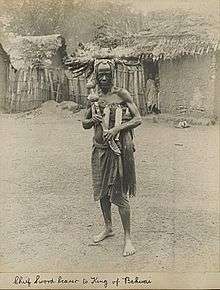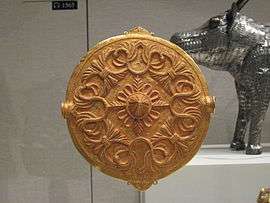Akrafena
An Akrafena (Ashanti sword) is an Ashanti sword, originally meant for warfare but also forming part of Ashanti heraldry. The foremost example of an akrafena is the Mponponson (meaning "responsibility"), which belonged to Opoku Ware II.[1] It has survived to the present day because it is still occasionally used in ceremonies, such as the Odwira festival.[2]
| Akrafena | |
|---|---|
More elaborate Ashanti swords have adinkra symbols in the ring and on the blade. | |
| Type | Sword / Fighting Knife / Machete |
| Place of origin | Ashanti |
| Production history | |
| Produced | Ashanti City-State (1670–1902) to present |
| Specifications | |
| Blade length | approx. 70–73 cm (27½–28½ in.) |
The expert use of akrafena is also a martial art, utilising the blade in conjunction with knives, improvised weapons, street-fighting, hand-to-hand combat, joint locks, grappling and weapon disarming techniques. The akrafena martial art is the national sport of the Ashanti City-State.
Design
The sword has three parts: a blade, usually made of some metal such as iron; a hilt of carved wood or metal; and the sheath, usually made of animal hide.
The blade in ritual swords may not have a sharp cutting edge. It often has incised lines or Ashanti symbolic designs on it, which evoke specific messages. Some swords have double (afenata) or triple (mfenasa) blades.
The hilt may be wrapped with gold leaf with various Ashanti symbols worked onto it. The hilt itself may be carved to encode an Ashanti symbol.
The sheath may carry an embossment (abosodee) that comprises Ashanti symbols meant to evoke certain expressive messages. The mpomponsuo (responsibility) sword of the Asantehene, for example, has an embossment of a coiled snake with a bird in its mouth. This conveys the Ashanti message: the puff adder that cannot fly has caught the hornbill that flies. This is used to symbolize patience, prudence, and circumspection.
Types
Traditionally there are about five types of Ashanti swords with some better known than others.
There are two main types of swords in the regalia of the Ashanti-Akan chief: Afenatene (Long sword) and the Short sword. The Afenatene usually does not have a sheath. It is, however, topped by an Ashanti Adinkra symbol. The short sword may be used as Akrafena or Nsuaefena (also known as Akrafena).[3]
• Akrafena: The Akrafena is used in wars, and in conjunction with an Ashanti stool blackening ceremony; The Akrafena may be carried by the king’s emissaries on Ashanti City-State diplomatic missions.[3] In such situations, the meaning associated with the Ashanti Adinkra symbol embossed on the sheath conveys the message of the mission.[3]
• Nsuaefena: The Nsuaefena is used in the Ashanti City-State political ceremony of taking the oath of office by the king and in swearing oath of allegiance by the subjects to the Ashanti emperor-king Asantehene.[3]
• Afenatene: is used by Ashantis to penetrate the Ashanti war opponents hearts. The Blade of an Afenatene sword shows the akoma (heart), denkyem (crocodile), akuma (axe) and the sankofa.[3]
• Afenanta: The Afenanta is a "Double Blade Sword" used by the Ashantis for cutting human ligaments during an Ashanti war.[3] The Afenanta has the Ashanti denkyem and sankofa symbols embroidered onto the blades.[3]
• Mpomponsuo: The Mpomponsuo sword symbolizes; Responsibility, Power, Loyalty, Bravery, and Authority.[3]
The Mpomponsuo sword is used by the Asantehene in taking the oath of office. The other Ashanti amanhene use the Mpomponsuo sword to swear the oath of allegiance to the Asantehene.[3] The Mpomponsuo sword is one of the four principal state swords of Ashanti City-State. The Asantehene sword was created by Asantehene Nana Opoku Ware I (r. 1731 – 1742), and is the foremost example of Akrafena.[3]
Akrafena as weapons
History
Bonoman Kingdom (10th century AD) and the Ashanti Empire States (13th century AD to 21st century)

Bonoman long swords were used primarily by Ashanti cavalry and commanders, not infantry during the 10th to 15th centuries. In the 16th century and at the time of Denkyira, Akyem and Akwamu land warfare consisted mostly of spearmen and bowmen on foot, mounted archers using two-handed bows, and mounted swordsmen with two-handed swords (twin blades). Ashanti Swords were not a primary weapon for all Ashanti combat but were mostly for Ashanti shock attacks, defensive strokes and close combat. Blades were heavy as they were made of bronze and later iron, and pommels were often knobbed and used as balances. Short swords may have been used in follow-up attacks, as short sword carriers were armoured completely and accompanied with a shield.
Ashanti Akrafena Swords with wooden or metal pommels decorated with beaten gold have featured in Ashanti court regalia since the 17th century AD. Ashanti Swords were used during Ashanti wars since the 17th century. The Ashantis were engaged in a series of military conflicts from the 18th century AD, between Ashanti City-State military forces and African states and European states up until the 20th century.
In the 21st century, the Ashanti Swords are primarily by Ashantis for self-defense, and the Ashanti Akrafena (Ashanti Sword of war) is primarily used for Ashanti warfare and land warfare.
During the Empire of Ashanti period, Ashanti swords also had ranks (hierarchy) depending on who wielded them and what their purpose was. The highest ranking of these swords was known as the Mpomponsuo, literally meaning "responsibility sword." Only two such swords existed and were wielded by the King's two bodyguards, who always stood on either side of him and held the nobility title of Ankobia.
Ashanti swords and shields of war (twenty-first century): changing needs and tactics
The Ashanti Akrafena (Sword of my Soul) was generally held in the hand by Ashanti Asafos. There was no real reason to hold it on their sides. However, they did strap it to their back at times when they were traveling through the rain-forest regions of Ashanti City-State or using other weapons such as spears and bows. The Ashanti sword was first and foremost one-handed, though for more powerful strikes, two hands were used. The Ashanti techniques were generally hand and a half.
Akrafena as an Ashanti national symbol

The Akrafena also an Ashanti national symbol, adopted by Ashanti City-State's emperor-king Asantehene Opoku Ware I in 1723. In this context it is known as Akofena.[4][5]
Heraldic description

The Blazon: The akrafena is used in conjunction with the stool blackening ceremony. Nsuaefena is used in the political ceremony of taking the oath of office by the king and in the swearing oaths of allegiance by subjects of Ashanti City-State. The akrafena also may be carried as a heraldic device, by the Ashanti emperor's-king’s emissaries on Ashanti City-State diplomatic missions. In such situations the meaning associated with the symbol embossed on the sheath conveys the message of the mission. Blade of an afenatene sword showing the akoma (heart), denkyem (crocodile), akuma (axe) and the sankofa bird.[6]
The Ashanti national symbol Akrafena description:
- The Akrafena is a prominent symbol of the Ashantis in the 18th, 19th and 20th centuries into the 21st century;
The Akrafena as an Ashanti national symbol has the escutcheon meaning; Akrafena ("Symbol of courage, valor, and heroism").
History
The Ashanti Akrafena sword as an Ashanti City-State national symbol was used by the Asantehene in taking the oath of office as ruler of Ashanti City-State. The Omanhene used the Ashanti Akrafena sword to swear the oath of allegiance to the Asantehene and Ashanti City-State.[4] The Ashanti Akrafena sword is one of the four principal state swords of the Ashanti City-State. The first Ashanti Akfrafena sword was created by Asantehene Nana Opoku Ware I (r. 1731 – 1742), and is the foremost example of Akrafena. The mpomponsuo sword symbolizes Responsibility, Power, Loyalty, Bravery, and Authority.[4]
Akrafena as martial art
 | |
| Also known as | Akrafena Akofena |
|---|---|
| Focus | Sword fighting Knife fighting Unarmed combat Street-fighting Striking attacks Clinch-fighting |
| Hardness | Eclectic / Hybrid |
| Country of origin | |
| Creator | Ashanti City-State |
| Famous practitioners | Osei Tutu I Osei Tutu II |
| Olympic sport | No |
There are Ashanti City-State schools that hold the techniques of these swords practitioners in the past. The schools hold the genuine Ashanti Swords techniques.[7]
It is said that there were 20 fighting postures in training; The Ashanti people practitioners of the past generally used low kicking techniques to distract, dismantle and disable the opponent when holding the sword in one hand and sheath in the other. The sword-based fighting techniques is similar in part to that of Eskrima and the combat hand-techniques and kicking techniques is similar in part to that of Wing Chun.[7]
Akrafokonmu (Ashanti Shield of war)

The Ashantis Shield historically used during Ashanti wars
Early European visitors to the Ashanti city-state described dazzling displays of court regalia at the court of the Asantehene in Kumasi.[8] The region's natural gold resources had made the Ashanti people wealthy and court regalia, which included textiles (kente), ivory and gold, reflected high levels of skill.[8]
The Akrafokonmu (Ashanti Shield) is made out of iron and cast in gold. The Akrafokonmu was threaded onto a stick to which white pineapple fibre cord was tied to the ends so that it could be worn around the neck by those responsible for the ritual purification of the Asantehene's soul.[8] The Ashantis call the shields "Akrafokonmu", usually translated as "soul discs" or "soul washers' badges".[8]
This shield's design of a quartered circle has been identified as 'nkwantaanan' ('nkwan' ‘paths’ or ‘roads’, 'anan' ‘four’). Crossroads were considered to be places of spiritual and cultural significance.[8]
Gallery
 Ashanti 18th to 19th centuries Gold Akrafena.
Ashanti 18th to 19th centuries Gold Akrafena..jpg) Ashanti 18th to 19th centuries Silver Akrafena.
Ashanti 18th to 19th centuries Silver Akrafena. Ashanti Middle Ages Akrafena.
Ashanti Middle Ages Akrafena.
See also
- Adinkra
- Bosomfena
References
- Fraser, Douglas (2004). African Art and Leadership. University of Wisconsin Press. p. 145. ISBN 9780299058241.
- Adams, Frank Kwesi (2010). Odwira and the Gospel: A Study of the Asante Odwira Festival and Its Significance for Christianity in Ghana. OCMS. p. 138. ISBN 9781870345590.
- Collins and Burns (2007), p. 140.
- Symbols of Ashanti: Akofena
- Ashanti Community, Society, History and Culture
- Akua, Nana; Opokuwaa, Kyerewaa (2005). Ashanti Protocol: Remembering the Traditions of Our Ancestors. iUniverse. ISBN 978-1-4759-2048-2.
- Davidson (1991), p. 242.
- Collins and Burns (2007), pp. 140–141.